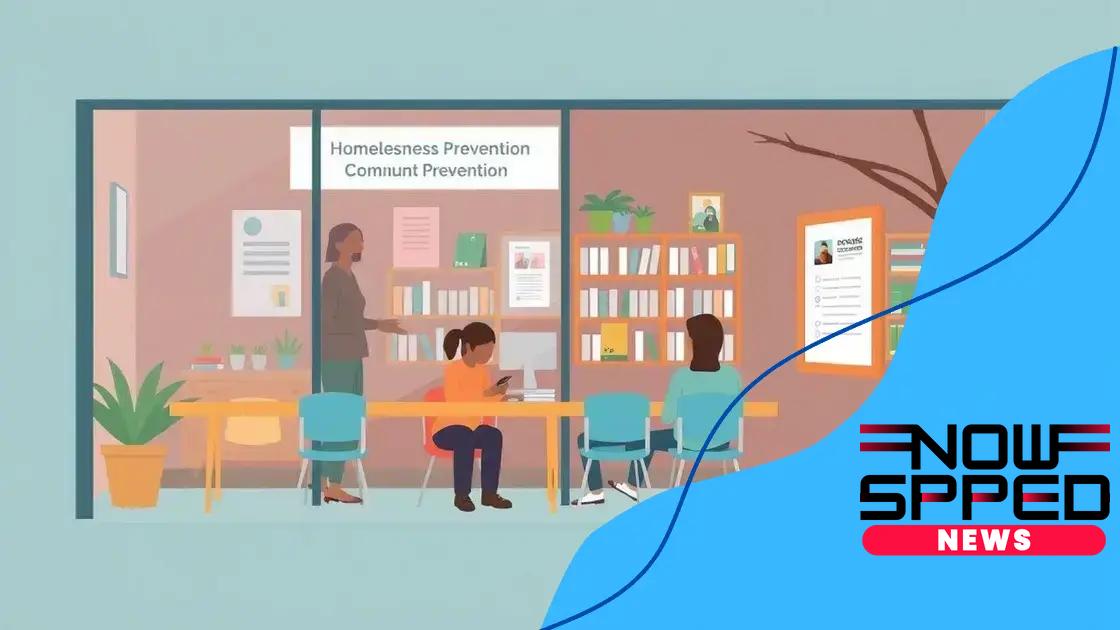Homelessness prevention and long-term support programs

Homelessness prevention and long-term support programs focus on providing affordable housing, job training, and community resources, effectively addressing the root causes of homelessness to create lasting stability for individuals.
Homelessness prevention and long-term support programs play a vital role in helping individuals stay off the streets. Have you ever wondered how these initiatives work and what they can accomplish? Let’s dive into this important topic.
Understanding the root causes of homelessness
Understanding the root causes of homelessness is essential to developing effective solutions. Many people wonder why someone would become homeless. The reasons are often complex and multi-faceted.
There are several contributing factors that can lead to homelessness. Poverty is one of the most significant factors. Individuals living in poverty may struggle to pay rent and afford other essentials. Without adequate financial resources, they risk losing their homes. Additionally, mental health issues can play a crucial role. Many individuals experiencing homelessness face challenges like depression, anxiety, or other conditions that make it difficult to maintain stable housing.
Common factors leading to homelessness
- Substance abuse: Addiction can severely impact a person’s ability to hold a job and pay bills.
- Family conflicts: A breakdown in family relationships can lead to an increase in homelessness, especially among youth.
- Lack of affordable housing: In many areas, affordable housing is scarce, pushing individuals out of stable living situations.
- Job loss: Sudden unemployment can leave individuals without the means to pay for housing.
Another major factor is the lack of support systems. Individuals without supportive relationships or networks can find it challenging to navigate tough times. Without family or friends to rely on, they may turn to the streets. This issue highlights the importance of community resources that can provide help and support.
Long-term effects of homelessness
Homelessness can have lasting effects on individuals. Many experience greater health problems, low self-esteem, or persistent feelings of isolation. This can create a cycle that is hard to break. Programs aimed at addressing these root causes are crucial for prevention. By understanding these factors, we can better advocate for homelessness prevention and long-term support programs that address the needs of the most vulnerable.
Key components of effective prevention programs
Effective prevention programs for homelessness focus on addressing the core issues that lead individuals to lose their housing. Understanding these key components is essential for creating lasting solutions.
One critical aspect is providing affordable housing. Without access to stable and affordable places to live, many people find themselves at risk of homelessness. Programs must prioritize housing as a fundamental need. In addition to housing, financial assistance plays a significant role. This can include help with rent payments, utilities, and other expenses that can overwhelm individuals in difficult situations.
Comprehensive support services
Alongside housing and financial aid, comprehensive support services are vital. These services can help individuals maintain stability. Case management is often part of these services, guiding individuals through available resources and support systems.
- Employment training: Providing skills training can help individuals secure stable jobs and increase their income.
- Counseling services: Mental health counseling can address the underlying issues that contribute to housing instability.
- Substance abuse programs: Support for those struggling with addiction is crucial in preventing relapse into homelessness.
- Legal assistance: Helping individuals navigate eviction notices and legal disputes can prevent homelessness before it starts.
Additionally, effective communication and collaboration among service providers can make a difference. Partnerships between government agencies, non-profits, and local communities help create a stronger network of support for those in need. Programs must also engage the community. By educating the public and building awareness, communities can create supportive environments that help prevent homelessness.
Data-driven approaches
Data plays an important role in designing effective programs. Analyzing trends and outcomes allows organizations to tailor their interventions to the specific needs of the population they serve. Continuous evaluation and adaptation of programs ensure that they meet the needs of individuals effectively and efficiently.
The role of community support in long-term solutions

The role of community support in long-term solutions for homelessness is incredibly significant. Communities that come together can create a powerful network of assistance for those in need. By providing resources, encouragement, and connections, local efforts can help individuals find stable housing and build fulfilling lives.
One essential aspect of community support is awareness and education. When community members understand the issues related to homelessness, they are more likely to get involved. Educational programs can inform people about the challenges faced by individuals experiencing homelessness. This knowledge can lead to empathy and a willingness to help.
Building strong networks
Strong community networks are vital in preventing homelessness. By forming partnerships between local organizations, residents, and businesses, communities can develop comprehensive support systems. These networks can offer essential services such as:
- Food and shelter programs: Local food banks and shelters help meet immediate needs.
- Job training: Offering skill-building workshops can lead to employment opportunities.
- Health services: Access to healthcare can address both physical and mental health issues.
- Peer support groups: Connecting individuals with others who understand their struggles fosters a sense of belonging.
In addition to formal services, informal community support plays a key role. Neighbors can look out for one another, helping those who are struggling. Simple gestures, such as sharing meals or offering a listening ear, can significantly impact someone’s life.
Volunteering and giving back
Volunteering is another way to strengthen community support. Residents who dedicate their time to assist local organizations can make a difference. People can participate in food drives, serve in shelters, or help with educational workshops. Not only does volunteering provide immediate relief to those in need, but it also builds connections among community members. This sense of unity can help spark further initiatives aimed at combating homelessness.
Ultimately, community support is essential in creating long-term solutions to homelessness. By working together, locals can provide the necessary resources and encouragement for individuals to overcome challenges and build stable lives. Neighborhoods that embrace this responsibility foster environments where everyone has the opportunity to thrive.
Success stories: How programs make a difference
Success stories from homelessness prevention programs serve as powerful examples of how targeted efforts can make a meaningful difference. These stories highlight the impact of community initiatives and the resilience of individuals working toward stable lives. Every success story emphasizes the potential for positive change when resources are allocated effectively.
One remarkable example involves a job training program that helped individuals gain essential skills. Participants received training in fields such as construction, hospitality, and healthcare. Many graduates not only secured jobs but also found pathways to career advancement. These opportunities not only provided financial stability but also boosted self-esteem and personal growth.
Transformative housing programs
Another transformative success story comes from a supportive housing program that paired individuals with affordable housing and case management services. This program focused on people with a history of homelessness, providing them a stable environment. Within months, residents reported improved mental health and a renewed sense of community. The combination of safe housing and support helped many rebuild their lives.
- Access to healthcare: Residents received medical care, addressing issues that had contributed to their homelessness.
- Connection to social services: Many utilized counseling and addiction resources to facilitate recovery.
- Reintegration into the community: Participants developed friendships, fostering a sense of belonging.
Furthermore, organizations that facilitate networking among former participants create a lasting impact. Formerly homeless individuals often volunteer to help current participants. This peer support strengthens ties within the community and builds hope for those still in difficult situations.
Real people, real change
Stories of personal transformation are the heart of every successful program. Take the case of Sarah, a single mother who, after facing eviction, entered a prevention program. With assistance in finding stable housing and accessing job training, she went from struggling to thriving. Now, Sarah is a mentor for other participants, sharing her journey and encouraging them to pursue their goals.
These success stories show that while the challenges of homelessness are significant, solutions exist. Programs that provide comprehensive support can lead to lasting change. Their successes inspire communities to continue investing in prevention and support efforts, further amplifying the positive impacts.
Future challenges in homelessness prevention
Future challenges in homelessness prevention present significant hurdles that require attention and action. These challenges come from various sources, including economic factors, social issues, and changing demographics. Addressing these challenges is crucial to ensuring the success of homelessness prevention programs.
One major challenge is the affordability of housing. As cities grow and populations increase, the demand for affordable housing continues to rise. Many low-income individuals and families find it increasingly difficult to secure stable housing. This problem may worsen without swift action from governments and organizations to increase the availability of affordable options.
Economic instability
Another challenge stems from economic instability. Job losses, wage stagnation, and rising living costs create financial pressure on households. Economic downturns can lead to increased evictions and homelessness. Prevention programs must adapt to these shifts by offering more robust financial assistance and employment support.
- Rising costs of living: Many areas see significant increases in rent, making it harder for low-income residents to find housing.
- Income inequality: The gap between high and low earners continues to widen, leaving many people without the means to afford basic needs.
- Job market shifts: Automation and technological changes can eliminate traditional jobs, reducing opportunities for unskilled workers.
Moreover, mental health and substance abuse issues remain prevalent among those experiencing homelessness. Addressing these problems in prevention strategies is essential. Programs must integrate mental health services and substance abuse resources to support individuals effectively. Without focusing on these areas, prevention efforts may be compromised.
Community engagement
Engaging the community is also vital for effective prevention. Continued collaboration between government agencies, non-profits, and local organizations allows for comprehensive solutions. However, as the number of individuals needing assistance grows, sustaining engagement becomes more challenging. Keeping community members informed and involved is crucial to maintaining momentum in addressing homelessness.
Finally, changes in population demographics present a challenge for homelessness prevention programs. Understanding the changing needs of diverse populations can help tailor initiatives efficiently. Programs must adapt their outreach strategies to connect with various communities. This adaptability can improve access to essential services and resources for those who need them most.
FAQ – Frequently Asked Questions about Homelessness Prevention Programs
What are the main causes of homelessness?
The main causes include poverty, lack of affordable housing, job loss, and mental health issues.
How can community support help prevent homelessness?
Community support provides resources like food, job training, and housing assistance, fostering stability for individuals.
What role does job training play in preventing homelessness?
Job training equips individuals with the necessary skills to secure employment, increasing their financial stability.
Why is mental health support important in homelessness prevention?
Mental health support addresses underlying issues that contribute to homelessness, helping individuals maintain stable housing.





